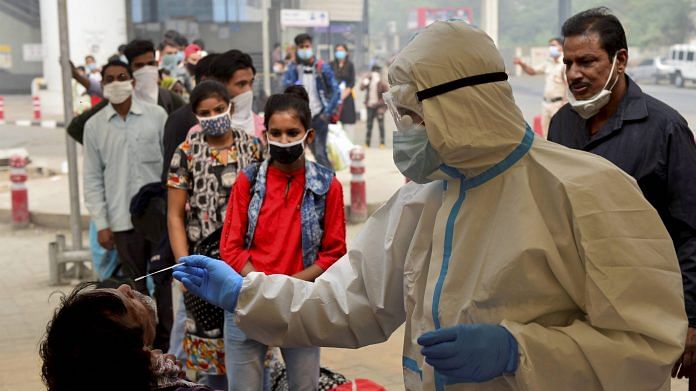
New Delhi: India’s nosediving Covid-19 numbers may have come as a relief but till November, the country had missed about 90 infections for every detected case.
While states like Delhi and Kerala had missed just about 25 infections for every case, Uttar Pradesh and Bihar are estimated to have missed about 300 infections for every case detected. A case in medical terms refers to an infection that has been medically diagnosed.
An analysis of India’s Covid numbers till last month has thrown up these figures. It was conducted by members of a panel formed by the Department of Science and Technology (DST), the same committee that developed the India-specific supermodel that predicted that the pandemic will taper off by February 2021 in India. An analysis in September had shown that India had missed about 60-65 infections for every detected case.
“We have been doing state-wise analysis and currently that shows that till about mid-November, Delhi and Kerala missed about 25 infections for every case. The number is about 300 for every case in UP and Bihar. Most states are in the 70-120 range,” Manindra Agrawal, a member of the DST’s committee and computer science professor at IIT Kanpur, told ThePrint.
“The India figure is about 90 infections missed for every case. If you compare that with countries like Italy and the United Kingdom, it is about 10-15 missed infections for every case,” he said.
“In fact our model shows that while the third peak in Delhi was bigger, the actual spread of the infection was almost the same. During the second peak, Delhi missed 43 infections per case while in the third it missed just 21. That is because the Delhi government had stepped up testing,” added Agrawal.
Apart from Agrawal, the DST committee included professor M. Vidyasagar of IIT Hyderabad, Dr Gagandeep Kang of CMC Vellore, professor Biman Bagchi of Indian Institute of Sciences, Bengaluru, professors Arup Bose and Sankar Paul of Indian Statistical Institute, Kolkata, and Lt Gen. Madhuri Kanitkar from the Ministry of Defence.
The earlier findings were published in a pre-print article in the Indian Journal of Medical Research, authored by Agrawal, Vidyasagar and Kanitkar.
‘India’s inefficiency helped’
Agrawal is emphatic that India, according to the supermodel projections, will not see another peak and sticks to the committee’s original projections of February 2021, i.e., the country will see an end of the pandemic with about 20,000 active cases. This is partly because of the large numbers of undetected infections.
“India level we do not expect another peak now. Broadly, the numbers will continue tapering off. Currently, as per the model, about 60 per cent Indians have already been infected, they have antibodies,” he said.
“That is corroborated by the fact that even after the festival season, except Delhi, not many states saw a spike. Some states may go up a bit. Uttarakhand is currently rising, so is Meghalaya,” he added.
If India does end up with a single Covid peak, it will be an outlier. Most countries around the world have seen multiple peaks. The United Kingdom is going through one currently, Germany has imposed a second lockdown and Sweden, the original proponent of herd immunity, is struggling.
Asked about the rationale for India getting away with just one peak — in September — Agrawal said: “Our inefficiency has helped us here. Germany, for example, when they announced a lockdown, everything was shut, people stopped going out. But here, after the first month or so, it has largely been a leaky lockdown and mask compliance has been poor.
“So the infection spread in the population. Countries like Germany still have a lot of uninfected population. There are also other factors such as South Asia, Africa in general have been less affected. That could be because of a younger population or there may be other factors at play. Experts are analysing that.”
Subscribe to our channels on YouTube & Telegram
Why news media is in crisis & How you can fix it
India needs free, fair, non-hyphenated and questioning journalism even more as it faces multiple crises.
But the news media is in a crisis of its own. There have been brutal layoffs and pay-cuts. The best of journalism is shrinking, yielding to crude prime-time spectacle.
ThePrint has the finest young reporters, columnists and editors working for it. Sustaining journalism of this quality needs smart and thinking people like you to pay for it. Whether you live in India or overseas, you can do it here.